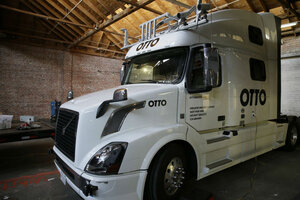Uber's self-driving big rig plan: What does it mean for truck drivers?
Uber, which acquired self-driving truck startup Otto this summer, plans to get long-haul trucks on the roads next year. How will it affect those who are involved?

An Otto driverless truck at a garage in San Francisco. Uber, which acquired the company this summer, hopes to get the vehicles on the road next year.
Eric Risberg/AP/File
Uber, best known for its ride-hailing app, has been branching out lately. UberEATS now makes food deliveries worldwide, while self-driving cars are beginning to accept passengers on the streets of Pittsburgh. The company’s latest venture: long-haul driverless trucking.
After acquiring self-driving truck startup Otto, Uber hopes to make inroads into the nation’s $700-billion-a-year trucking industry. Otto co-founder Lior Ron told Reuters that the six-truck company will expand to 15 trucks, and looks to begin hauling cargo as early as 2017.
It’s still early days for driverless technology: Otto trucks have a driver and an engineer on board at all times. What, then, does the arrival of self-driving big rigs mean for truckers and for long-haul shipping companies? While Uber and others are keen to get these vehicles on the roads, some suggest that drivers’ jobs will be around for years to come.
“It’s important that there be a full understanding in testing of the potential benefits and risks, as well as limitations – our current infrastructure being one. We believe experienced, skilled drivers will be needed well into the future,” Kara Deniz, press secretary for the International Brotherhood of Teamsters, tells The Christian Science Monitor in an email.
Otto, which began by retrofitting existing trucks with self-driving technology, was originally intended to improve safety in trucking. In the United States, around 438,000 large trucks were involved in crashes reported to the police in 2014, according to the National Highway Traffic Safety Administration.
The company originally focused on freeway trucking only, meaning that drivers would still be necessary for the rest of the journey. Uber is looking to expand this to meet more of truckers’ needs. The company also seeks to leverage its mapping and logistics expertise to “connect the dots” and create a more seamless experience for truckers and shippers.
“In Uber, you press a button and an Uber shows up after three minutes,” Mr. Ron explained to Reuters. “In freight ... the golden standard is that it takes [the broker] five hours of phone calls to find your truck. That’s how efficient the industry is today.”
Why the focus on autonomous trucks rather than cars? While Uber is currently piloting its self-driving cars in Pittsburgh, self-driving trucks may be in widespread commercial use sooner. Autonomous technology now looks more cost-effective in the operation of a truck than private vehicles, notes a report from the Center for Technology Innovation at the Brookings Institution: large trucks often cost more than $150,000, and a driver’s salary is around $40,000 per year. Otto’s retrofit reportedly runs around $30,000.
Self-driving trucks could help address an industry shortfall. The American Trucking Association reported last year that drivers are aging, contributing to a driver shortage expected to reach nearly 48,000 by the end of 2015, and was forecast to grow. The safety and professionalism requirements made on drivers mean companies struggle to find qualified drivers. The retirement of drivers and the development of self-driving technology may actually help create a smoother transition from driver-operated vehicles to autonomous ones than some critics have predicted, though “motor carriers should not count on this being an option for some time,” the report concluded.
Of course, that doesn’t mean drivers are necessarily happy about the prospect. “It’s going to be a huge problem,” Andy Stern, former president of the Service Employees International Union, told The Guardian. “It’s the largest job in 29 states.” He pointed out that businesses will be quick to take advantage of any labor-saving technology, possibly leaving truckers without a job.
Arthur Molella, director emeritus of the Jerome and Dorothy Lemelson Center for the Study of Invention and Innovation, part of the Smithsonian Institution, says the tug between people doing jobs and mechanization to change or replace those jobs is a centuries-old question.
“This goes back to the Luddites and the fear that the new spinning machinery was going to destroy the lives and work possibilities of textile workers,” he says in a phone interview with the Monitor. He explains that “there’s no consensus yet” on whether increased use of technology produces structural unemployment or eventually lifts the job market.
“The immediate effect can be quite devastating for people who have a particular skill, of which truck-driving would be a good example,” Joel Mokyr, professor of economic history at Northwestern University, tells the Monitor in a phone interview. “For those who are a bit older, it could be a bit harder for them to retool, so it could be career-ending.” But, he says, the experience of sailors as steam engines began to be introduced may prove encouraging. “It took so long [to replace the sails with steam engines] that I don’t recall any instances of sailors being made redundant.”
Some groups envision a productive cooperation between makers of automated truck technology, like Otto, and current drivers. This may include working together to produce a regulatory framework for fully autonomous trucks. Federal guidelines for autonomous cars were released last week.
“I believe automated vehicle technology will actually enhance the skills of the 3.5 million professional drivers who currently move the nation’s freight; and could improve safety, ease congestion and reduce emissions,” Chris Spear, American Trucking Association president and chief executive officer, tells the Monitor in an email.

